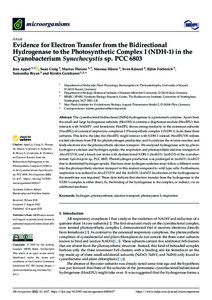Evidence for Electron Transfer from the Bidirectional Hydrogenase to the Photosynthetic Complex I (NDH-1) in the Cyanobacterium Synechocystis sp. PCC 6803
| dc.date.accessioned | 2022-09-17T08:29:39Z | |
| dc.date.available | 2022-09-17T08:29:39Z | |
| dc.date.issued | 2022-08-10 | |
| dc.identifier | doi:10.17170/kobra-202209176865 | |
| dc.identifier.uri | http://hdl.handle.net/123456789/14151 | |
| dc.description.sponsorship | Gefördert durch den Publikationsfonds der Universität Kassel | ger |
| dc.language.iso | eng | |
| dc.rights | Namensnennung 4.0 International | * |
| dc.rights.uri | http://creativecommons.org/licenses/by/4.0/ | * |
| dc.subject | hydrogen | eng |
| dc.subject | photosynthesis | eng |
| dc.subject | electron transport | eng |
| dc.subject | photosystem I | eng |
| dc.subject | respiration | eng |
| dc.subject.ddc | 570 | |
| dc.title | Evidence for Electron Transfer from the Bidirectional Hydrogenase to the Photosynthetic Complex I (NDH-1) in the Cyanobacterium Synechocystis sp. PCC 6803 | eng |
| dc.type | Aufsatz | |
| dcterms.abstract | The cyanobacterial bidirectional [NiFe]-hydrogenase is a pentameric enzyme. Apart from the small and large hydrogenase subunits (HoxYH) it contains a diaphorase module (HoxEFU) that interacts with NAD(P)+ and ferredoxin. HoxEFU shows strong similarity to the outermost subunits (NuoEFG) of canonical respiratory complexes I. Photosynthetic complex I (NDH-1) lacks these three subunits. This led to the idea that HoxEFU might interact with NDH-1 instead. HoxEFUYH utilizes excited electrons from PSI for photohydrogen production and it catalyzes the reverse reaction and feeds electrons into the photosynthetic electron transport. We analyzed hydrogenase activity, photohydrogen evolution and hydrogen uptake, the respiration and photosynthetic electron transport of ΔhoxEFUYH, and a knock-out strain with dysfunctional NDH-1 (ΔndhD1/ΔndhD2) of the cyanobacterium Synechocystis sp. PCC 6803. Photohydrogen production was prolonged in ΔndhD1/ΔndhD2 due to diminished hydrogen uptake. Electrons from hydrogen oxidation must follow a different route into the photosynthetic electron transport in this mutant compared to wild type cells. Furthermore, respiration was reduced in ΔhoxEFUYH and the ΔndhD1/ΔndhD2 localization of the hydrogenase to the membrane was impaired. These data indicate that electron transfer from the hydrogenase to the NDH-1 complex is either direct, by the binding of the hydrogenase to the complex, or indirect, via an additional mediator. | eng |
| dcterms.accessRights | open access | |
| dcterms.creator | Appel, Jens | |
| dcterms.creator | Craig, Sean | |
| dcterms.creator | Theune, Marius | |
| dcterms.creator | Hüren, Vanessa | |
| dcterms.creator | Künzel, Sven | |
| dcterms.creator | Forberich, Björn | |
| dcterms.creator | Bryan, Samantha | |
| dcterms.creator | Gutekunst, Kirstin | |
| dc.relation.doi | doi:10.3390/microorganisms10081617 | |
| dc.subject.swd | Synechocystis | ger |
| dc.subject.swd | Wasserstoff | ger |
| dc.subject.swd | NADH | ger |
| dc.subject.swd | Cyanobakterien | ger |
| dc.subject.swd | Photosynthese | ger |
| dc.subject.swd | Elektronentransport | ger |
| dc.subject.swd | Hydrogenasen | ger |
| dc.type.version | publishedVersion | |
| dcterms.source.identifier | eissn:2076-2607 | |
| dcterms.source.issue | Issue 8 | |
| dcterms.source.journal | Microorganisms | eng |
| dcterms.source.volume | Volume 10 | |
| kup.iskup | false | |
| dcterms.source.articlenumber | 1617 |
Dateien zu dieser Ressource
Das Dokument erscheint in:
-
Artikel [1186]


